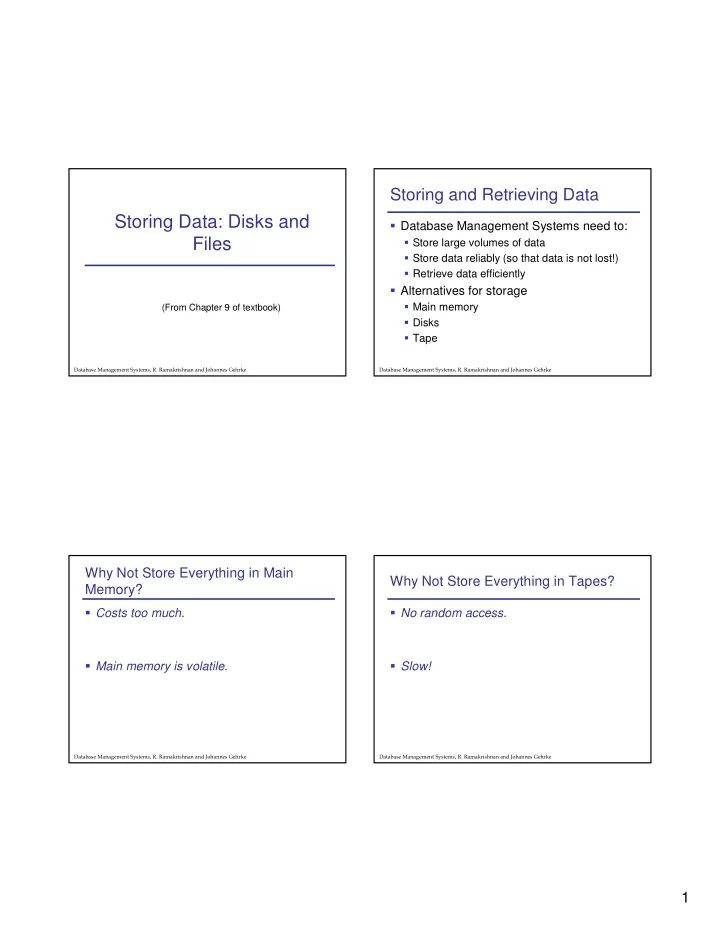

Storing and Retrieving Data Storing Data: Disks and � Database Management Systems need to: Files � Store large volumes of data � Store data reliably (so that data is not lost!) � Retrieve data efficiently � Alternatives for storage � Main memory (From Chapter 9 of textbook) � Disks � Tape �������������������������������������������� ������������������� �������������������������������������������� ������������������� Why Not Store Everything in Main Why Not Store Everything in Tapes? Memory? � Costs too much . � No random access . � Main memory is volatile . � Slow! �������������������������������������������� ������������������� �������������������������������������������� ������������������� 1
Solution 1: Techniques for Disks making disks faster � Secondary storage device of choice � Intelligent data layout on disk � Main problem? � Redundant Array of Inexpensive Disks (RAID) �������������������������������������������� ������������������� �������������������������������������������� ������������������� Solution 2: Buffer Management Outline � Keep “currently used” data in main memory � Disk technology and how to make disk read/writes faster � Buffer management � Typical (simplified) storage hierarchy: � Storing “database files” on disk �������������������������������������������� ������������������� �������������������������������������������� ������������������� 2
Components of a Disk Accessing a Disk Page � Time to access (read/write) a disk block: Spindle � Seek time: 1 to 20msec Tracks Disk head Sector � Rotational delay: 0 to 10msec v �������������� �������������������� ��������� � Transfer rate: ~ 1msec per 4KB page v ����������� �������������������������� Platters Arm movement � Key to lower I/O cost: reduce seek/rotation ��� ������������ ���!�������"��#� delays! Arm assembly �������������������������������������������� ������������������� �������������������������������������������� ������������������� Arranging Pages on Disk In-Class Exercise � Consider a disk with: � ` Next ’ block concept: � average seek time of 15 milliseconds � average rotational delay of 6 milliseconds � transfer time of 0.5 milliseconds/page � Page size = 1024 bytes � Table: 200,000 rows of 100 bytes each, no row spans 2 pages � Blocks in a file should be arranged � Find: sequentially on disk (by `next’), to � Number of pages needed to store the table minimize seek and rotational delay. � Time to read all rows sequentially � Time to read all rows in some random order �������������������������������������������� ������������������� �������������������������������������������� ������������������� 3
In-Class Exercise Solution RAID (Redundant Array of Independent Disks) � Disk Array: Arrangement of several disks that gives abstraction of a single, large disk. � Goals: Increase performance and reliability. � Two main techniques: � Data striping � Redundancy �������������������������������������������� ������������������� �������������������������������������������� ������������������� Parity RAID Levels � Add 1 redundant block for every n blocks � Level 0: No redundancy of data � Striping without parity � XOR of the n blocks � Level 1: Mirrored (two identical copies) � Example: D1, D2, D3, D4 are data blocks � Each disk has a mirror image (check disk) � Compute DP as D1 XOR D2 XOR D3 XOR � Parallel access: reduces positioning time, but D4 transfer only from one disk. � Store D1, D2, D3, D4, DP on different disks � Maximum transfer rate = transfer rate of one disk � Can recover any one of them from the other � Write involves two disks. four by XORing them �������������������������������������������� ������������������� �������������������������������������������� ������������������� 4
RAID Levels (Contd.) RAID Levels (Contd.) � Level 3: Bit-Interleaved Parity � Level 0+1: Striping and Mirroring � Striping Unit: One bit. One check disk. � Parallel reads. � Each read and write request involves all disks; � Write involves two disks. disk array can process one request at a time. � Maximum transfer rate = aggregate bandwidth � Combines performance of RAID 0 with redundancy of RAID 1. � Example: 8 disks � Divide into two sets of 4 disks � Each set is a RAID 0 array � One set mirrors the other �������������������������������������������� ������������������� �������������������������������������������� ������������������� RAID Levels (Contd.) RAID Levels (Contd.) � Level 5: Block-Interleaved Distributed Parity � Level 4: Block-Interleaved Parity � Similar to RAID Level 4, but parity blocks are � Striping Unit: One disk block. One check disk. distributed over all disks � Parallel reads possible for small requests, � Eliminates check disk bottleneck, one more large requests can utilize full bandwidth disk for higher read parallelism � Writes involve modified block and check disk �������������������������������������������� ������������������� �������������������������������������������� ������������������� 5
In-Class Exercise In-Class Exercise Solution � How does the striping granularity (size of a stripe) affect performance, e.g., RAID 3 vs. RAID 4? �������������������������������������������� ������������������� �������������������������������������������� ������������������� Which RAID to Choose? Which RAID to Choose? Corrected. � RAID 0: great performance at low cost, limited � RAID 0: great performance at low cost, reliability limited reliability � RAID 0+1 (better than 1): small storage � RAID 0+1 (better than 1): small storage subsytems (cost of mirroring limited), or when subsytems (cost of mirroring limited), or write performance matters when write performance matters � RAID 3 (better than 2): large transfer requests of � RAID 5 (better than 3, 4): good general- contiguous blocks, bad for small requests of purpose solution single blocks � RAID 5 (better than 4): good general-purpose solution �������������������������������������������� ������������������� �������������������������������������������� ������������������� 6
Recommend
More recommend